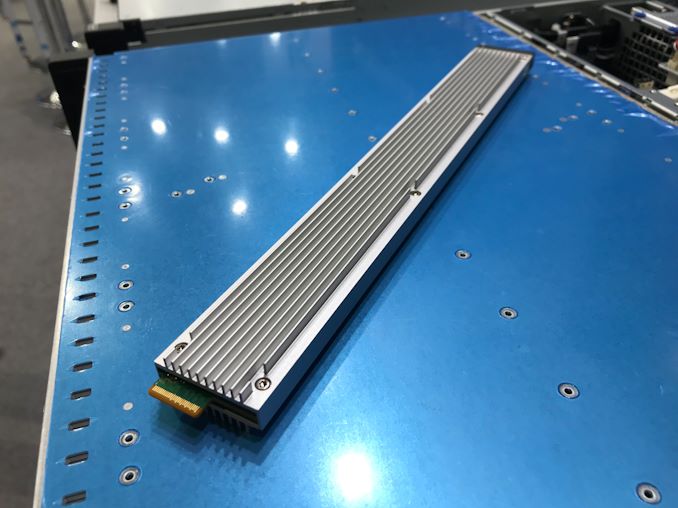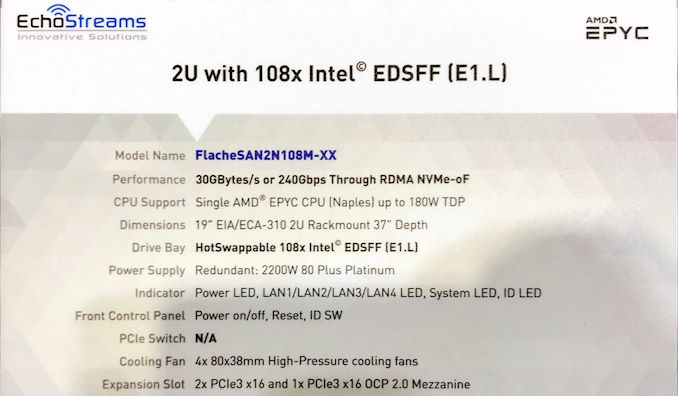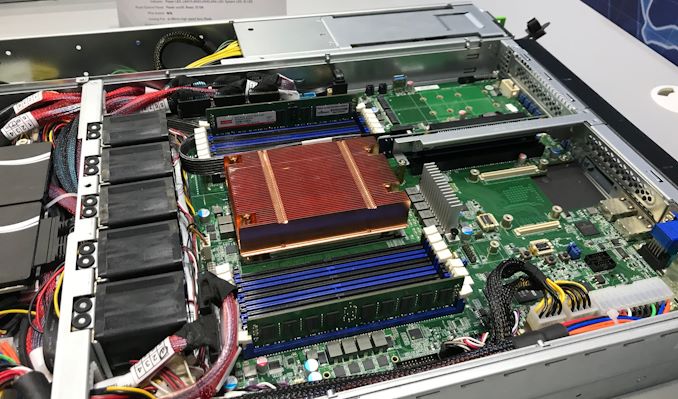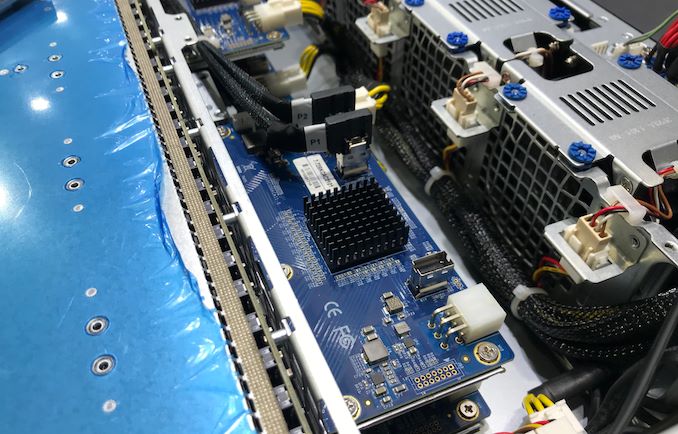Spotted at Computex: An AMD EPYC-Based System with 108 Intel Ruler SSDs
by Anton Shilov on June 6, 2019 11:00 AM EST- Posted in
- Servers
- AMD
- Trade Shows
- EPYC
- Computex 2019
- EchoStreams
- FlacheSAN

Intel’s ‘ruler’ SSD form-factor is meant to maximize density of solid-state storage devices and improve Intel’s competitive positions on two markets: storage and compute. As it turns out, AMD’s server platform can also benefit from Intel’s EDSFF E1.L drives thanks the number of PCIe lanes supported by the processor. In fact, at Computex we spotted one of the first AMD EPYC-based server carrying 108 E1.L ‘ruler’ SSDs.
EchoStreams’s FlacheSAN2N108N-XX is a 2U machine based on AMD’s EPYC ‘Naples’ with up to 32 cores accompanied by 16 DDR4 memory slots for up to 2 TB of RAM, several M.2 and PCIe slots for caching SSDs or accelerators, six Microsemi PCIe switches and so on. The key feature of the machine is the number of supported hot-swappable E1.L SSDs from Intel as well as storage capacities featured by 108 drives. At present, Intel offers DC P4500-series SSDs featuring up to 8 TB capacities, thus, the server can support a total capacity of up to 864 TB.
When it comes to performance, the FlacheSAN2N108N-XX offers up to 30 GB/s (or 240 Gbps) through RDMA NVMe-oF, it can support up to four NICs, though right now the company does not list exact models.
Intel developed its EDSFF (E1.L and E1.S) aka ‘ruler’ PCIe SSDs in a bid to increase NAND flash storage density in servers and make drives more thermally efficient. Meanwhile, because Intel’s current-generation Xeon Scalable CPUs have 48 PCIe lanes, whereas AMD’s existing EPYC processors feature 128 PCIe, AMD’s platforms can actually take more advantage of such SSDs than Intel’s own platforms.
The FlacheSAN2N108N-XX is already listed on EchoStreams’s website, so expect it to become available shortly. As for pricing, it will depend on exact configuration.
| Want to keep up to date with all of our Computex 2019 Coverage? | ||||||
 Laptops |
 Hardware |
 Chips |
||||
| Follow AnandTech's breaking news here! | ||||||














36 Comments
View All Comments
ilt24 - Thursday, June 6, 2019 - link
I doubt either would care. This is a case of a box maker taking a chassis they originally designed for Xeon processors and swapping out the motherboard for one with an AMD processor. Here is a link to the Xeon based system: https://echostreams.com/collections/flachestreams-...Atari2600 - Thursday, June 6, 2019 - link
Credit where it is due.Good work on the form factor innovation Intel.
Atari2600 - Thursday, June 6, 2019 - link
[from someone who still hasn't forgiven them for the illegal sh1te they were at in the early 2000s]scottpar28 - Thursday, June 6, 2019 - link
Forget Intel and put the Micron(3dxpoint) version on there. no complaintsDuncan Macdonald - Thursday, June 6, 2019 - link
Intel would make far more profit than AMD from that system. The price of the big batch of SSDs way exceeds the price of the AMD cpu. AMD gets bragging rights - Intel gets the cash.DigitalFreak - Thursday, June 6, 2019 - link
Almost a pedobyte of storage.Brown bar - Thursday, June 6, 2019 - link
Only the Vatican uses "pedobyte" its petabyte in the rest of the developed world.msroadkill612 - Friday, June 7, 2019 - link
8 naughty bits.Valantar - Thursday, June 6, 2019 - link
Comparing that to the size of m.2 drives (that reach 2TB single-sided), 8TB per drive seems ... low. But I guess few are willing to risk much more storage than that (or, well, twice that, given 16TB HDDs) on a single device, no matter the redundancy. Still, the form factor ought to fit tens of GB easily.nextgentech - Thursday, June 6, 2019 - link
108??? Sure looks like 72 to me, but 108 would be even worse:This architecture makes no sense for a 2U box, let's assume 2M hours MTBF/drive, now you've got 72 drives so your effective MTBF comes all the way down to a mere 27.7K hours not to mention there is no way to take advantage of the performance of all 72 of those drives, resulting in a lots of expensive drives with powerful NVMe ASICs going to waste.
You are better off going with fewer drives to match the performance capabilities of the server, i.e. right size the CPU and storage, this config results in a very mismatched setup and strands performance of that expensive NAND.